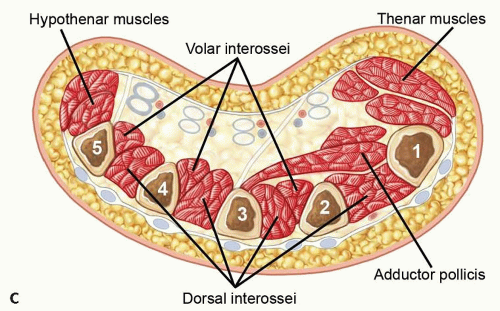
An intracompartmental pressure threshold of 30 mm Hg or greater was used to diagnose compartment syndrome. Seventeen assessors clinically judged the presence or absence of compartment syndrome based on digital palpation for firmness and then measured pressures with a handheld manometer. Three cadaveric hands were configured with interstitial fluid infusion and an arterial line pressure monitor to create and continuously measure intracompartmental pressure in the thenar and hypothenar compartments. To determine the accuracy of digital palpation for clinical assessment of elevated intracompartmental pressure compared with needle manometry in a simulated compartment syndrome of the hand. 19 We chose to use a conservative control pressure of 30 mm Hg as the threshold for diagnosis of compartment syndrome, consistent with Ouellette and Kelly, 4 who used 25 mm Hg as their threshold for performing fasciotomy in patients for whom they were unable to provide a reliable clinical examination. Normal compartment pressures in the hand and forearm range from 0 to 15 mm Hg. 18 Although the diagnosis of compartment syndrome using manometry is commonly based on calculation of the pressure differential, our cadaveric experiment required the use of an absolute pressure threshold to define compartment syndrome. In a study of hand volar and dorsal interosseous compartments, continuous infusion of the compartments with real-time observation demonstrated that the thin tissue creating the subcompartments became incompetent at pressures exceeding 15 mm Hg. However, subcompartmentalization of the thenar and hypothenar compartments may become clinically irrelevant at elevated tissue pressures. Appropriate figures of the clinical image and surgical decompression are presented as well. Faciotomies’ indications and operative technique are described in details. Signs and symptoms are reported, as well as guidelines of the technique of intracompartmental pressure measurement. Special considerations regarding hand compartments are presented, 3. A brief description of the hand compartment syndrome is presented. Our chapter includes the following sections: 1. Failing to manage this emergent condition properly leads to a significant hand disability.

Once the diagnosis of acute compartment syndrome has been made, decompression of all compartments is mandatory, in order to achieve a good outcome. Intracompartmental pressure measurement contributes to the diagnosis, but it is not always reliable. Pain out of proportion of injury and excessive swelling should raise suspicion towards a compartment syndrome. Diagnosis of compartment syndrome of the hand remains challenging. Eleven compartments are included in the hand and wrist. The hand is rarely affected, but if treated suboptimally, it results to a permanent loss of function. Compartment syndrome is defined by high pressures in a closed myofascial compartment, which affects initially the muscles and later the nerves and vessels.


 0 kommentar(er)
0 kommentar(er)
